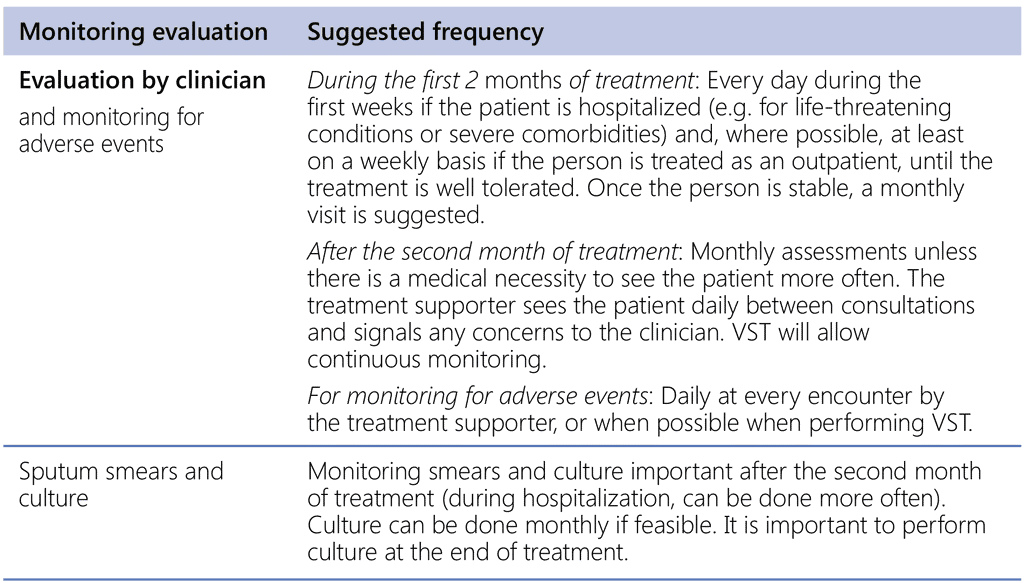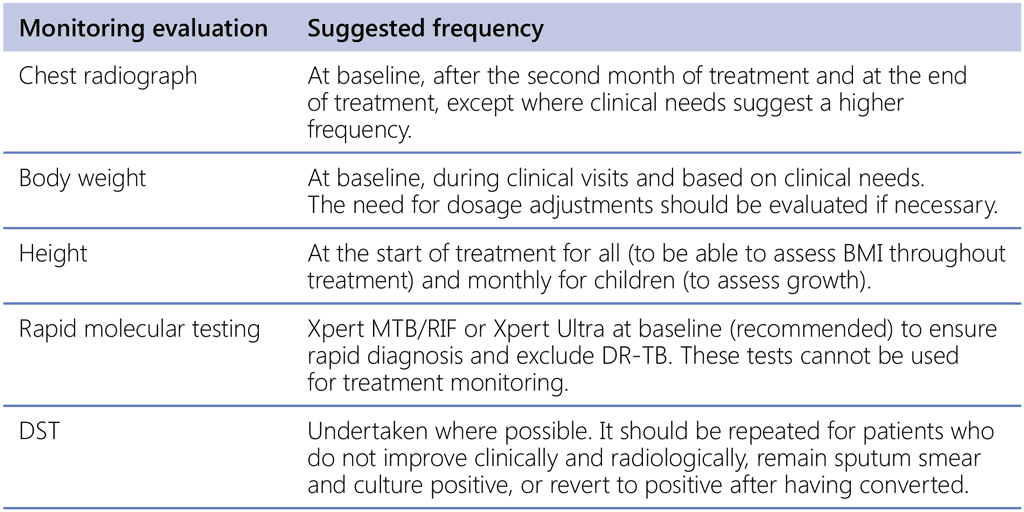كتاب روابط اجتياز لـ 9.3 Sputum smear and culture
Response to treatment in pulmonary TB patients is also monitored by bacteriological sputum smear examination and culture. For pulmonary DS-TB, the most important evidence of improvement is conversion of the sputum culture to negative. For extrapulmonary TB, sputum smears and cultures are only performed during the monitoring period if the patient develops pulmonary signs, or in the rare situation when materials valid for microbiological examinations are collected from the extrapulmonary site.
For people with DS-TB, sputum smear microscopy may be performed at the end of the second month of treatment. Sputum specimens should also be collected for smear examination at each follow-up sputum check. Specimen collection should not interrupt treatment, and specimens should be transported to the laboratory promptly; if a delay in transport is unavoidable, specimens should be refrigerated or kept as cool as possible.
A positive sputum smear at the end of the second month may indicate any of the following:
- even though the treatment response was good, non-viable bacteria remain present and are visible by microscopy;
- resolution is slow because the patient had extensive cavitation and a heavy initial bacillary load (this often occurs in cases of late diagnosis); and
- a poor treatment response occurred for one of the following reasons: – the initial phase of therapy was poorly supervised and patient adherence was poor;
– the initial phase of therapy was poorly supervised and patient adherence was poor;
– anti-TB drugs were of suboptimal quality;
– doses of anti-TB drugs are below the recommended range;
– the patient has comorbid conditions that interfere with either adherence or treatment response (e.g.diabetes or cancer);
– the patient may have undetected DR-TB that is not responding to first-line treatment; or
– although this is rare, the patient either does not absorb, or has suboptimal absorption of, one or more anti-TB drugs (73).
Sputum culture can be used for treatment monitoring. Although monthly culture is recommended for MDR/RR-TB cases (18, 73, 92, 93), this can also be useful for DS-TB, particularly at the end of the second month of treatment and at the end of treatment if the patient does not improve clinically, or at any other time if failure is suspected because of possible drug-resistance. Where drug-resistance is suspected, DST needs to be performed – the core of which is to test for resistance to isoniazid, rifampicin and moxifloxacin (if used) – and, if possible, to undertake DST using rapid tests for secondline drugs (91).
The reasons behind a positive culture during treatment monitoring are the same as those mentioned above for sputum smear; however, a difference is that a positive culture indicates that viable bacilli are present.
Molecular tests such as Xpert MTB/RIF are not used to monitor response to treatment.
Although sputum smear is useful because of its much shorter turnaround time, sputum culture is much more sensitive for detection of ongoing active disease or treatment failure. Therefore, culture is useful to monitor the progress of treatment. Sputum smear and culture examinations depend on the quality of the sputum produced, so care should be taken to obtain adequate specimens and transport them to the laboratory according to standard procedures, to maintain the viability of the bacilli and thus obtain a valid culture result. A tracking system should be in place for all specimens sent for culture until results are obtained by the referring facility or clinician.
Where sputum smears and cultures are persistently positive for acid-fast bacilli, it is necessary to undertake assessment for non-TB mycobacteria (NTM), because colonization or infection with NTM secondary to TB in a damaged lung is not uncommon. In such cases, even where TB is adequately treated, treatment may need to be directed towards the NTM as well. Additional imaging and possibly bronchoscopy should be considered, to confirm the diagnosis of NTM infection leading to disease (94)
Culture conversion is not equivalent to cure. Some patients may initially convert and later revert to positive sputum culture, usually when undetected drug-resistance is present. In rare cases, malabsorption can be the cause.
DST should be repeated for patients who remain smear and culture positive, or for whom treatment failure is suspected. In such cases, it is usually not necessary to repeat DST within 2–3 months of the previous DST. Table 9.1 summarizes the activities involved in and the frequency of monitoring.
Table 9.1. Summary of activities for monitoring treatment response


BMI: body mass index; DR-TB: drug-resistant TB; DST: drug susceptibility testing; TB: tuberculosis; VST: video-supported treatment.

 تعليق
تعليق